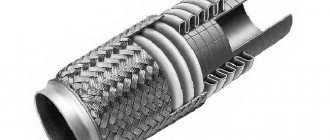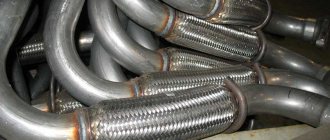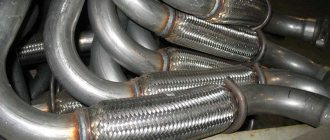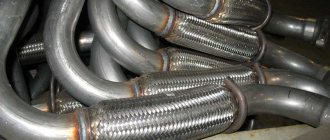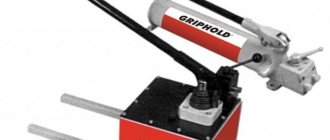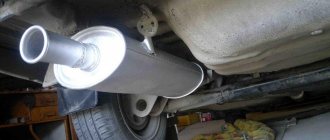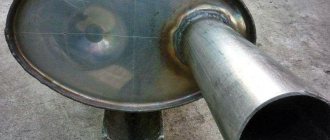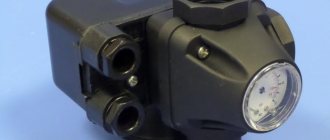The muffler sealant allows you to repair exhaust system elements without dismantling if they are damaged. These products are heat-resistant ceramic or elastic sealants that ensure the tightness of the system. When choosing a particular sealant for muffler repair, you need to pay attention to its operational characteristics - maximum operating temperature, physical condition, ease of use, durability, warranty period, etc.
Domestic and foreign car enthusiasts use a number of popular sealants for the car exhaust system. This material provides a brief overview of the most popular and effective sealants with a description of their operation, as well as an indication of the packaging volume and current price.
| The name of the most popular sealant from the line | Brief description and features | Volume of packaging sold, ml/mg | Price of one package as of summer 2022, Russian rubles |
| Liqui Moly Auspuff-Reparatur-Paste | Exhaust system repair paste-sealant. Maximum temperature - +700°C, odorless. Shows itself well in practice. | 200 | 420 |
| Ceramic sealant Done Deal | Excellent for both repair and installation work. Increases the service life of the exhaust system by 1.5...2 years. Very dense and thick. The only disadvantage we can note is rapid polymerization, which is not always convenient to work with. | 170 | 230 |
| CRC Exhaust Repair Gum | Adhesive-lubricant for repairing exhaust systems. Used to repair cracks and holes in the exhaust system. Maximum temperature - +1000°C. With the engine running, it hardens in 10 minutes. | 200 | 420 |
| Permatex Muffler Tailpipe Sealer | Sealant for muffler and exhaust system. Does not shrink after installation. Using the product you can repair mufflers, resonators, expansion tanks, and catalysts. Maximum temperature - +1093°C. Provides high tightness. | 87 | 200 |
| ABRO ES-332 | Repair cement for muffler, resonator, exhaust pipes and other similar elements. The maximum permissible temperature is +1100°C. With the engine running, it hardens in 20 minutes. | 170 | 270 |
| Bosal | Sealant cement for exhaust systems. Can be used as a repair and installation tool. It hardens very quickly, which is not always convenient. | 190 | 360 |
| Holts Gun Gum Paste | Sealant paste for repairing mufflers and exhaust pipes. Can be used on various equipment. | 200 | 170 |
DIY muffler repair without welding
In such a development of events, of course, it is necessary to repair the car, but this does not mean at all that you will have to print out an emergency supply of money that has been accumulated for a long time or take out a ruinous bank loan.
It is enough to spend a little time and effort - and the through hole can be eliminated with little means and with your own hands, and without the use of a welding machine.
After a well-carried out repair in a personal garage, the muffler will faithfully work for many more years, and with purely summer use of the car - up to five years.
Properties and selection
The material is made from harmless silica filament and graphite compounds. Available in the form of a tape of a certain width, heat-resistant.
The use of such material for the muffler winding guarantees the following:
- Increased engine power.
- Increased ventilation of the combustion chamber.
- Thermal insulation.
- Reduced temperature under the hood.
When purchasing, some points are taken into account:
- Heat resistance up to 1500 degrees.
- The width is selected depending on the convenience of the winding. 5 cm is enough.
- Tone: black, white, bronze.
Black and white ribbons are considered popular. Well suited for cars with low power. Black thermal tape absorbs heat from outside more than others, while white helps insulate the temperature under the hood.
Bronze material is more thermally insulating and is suitable for cars with more powerful engines.
We recommend watching the overview video:
Recommendations from the master
Not so long ago, the happy owners of Zhiguli and Moskvich cars, who today seem to be true Kulibins, knew and used a wide range of quite effective methods for restoring the performance of the muffler.
Due to the fact that in those days it was almost impossible to get its new analogue due to the shortage and considerable cost, Soviet car enthusiasts used the following methods:
- Installation of various types of iron hoops;
- Filling with cement and clay fillings that are resistant to strong heat;
- Wrapping with fiberglass;
- Preventive making of grooves to remove condensate;
- Coating the muffler with moisture-repellent chemical compounds created somewhere in closed military-industrial complex laboratories.
Important nuances
As we have seen, welding the muffler and corrugation for repair is not at all necessary. But there are some nuances in the above types of repairs.
The corrugation must be installed evenly, without distortions. At the end of the work, make sure that all brackets and hangers for attaching the muffler are intact and ensure its stability and immobility.
All three options for replacing corrugations will take no more than an hour. The part must be repaired at the first sign of a malfunction. Do not forget that timely replacement of the part is necessary for the further safe operation of the car.
Is it worth repairing the muffler yourself?
Currently, car mufflers and the components necessary for their operation can be purchased without even leaving home. There is no longer any shortage of such spare parts on the market, but they are still not cheap at all.
Signs of damage
- car “sneezing”, popping noises;
- engine power decreases;
- the rhythm of the engine becomes unstable;
- exhaust gases penetrate into the car interior;
- soot appears on metal parts.
There are three options for replacing the muffler corrugation without welding. The first two methods imply high-quality repairs with further long-term operation of the part. The third is a temporary replacement in order to get to the nearest service station. We will see that welding mufflers and corrugations, although desirable, is not at all necessary.
Wide selection of modern auto sealants
Naturally, any prudent and economical car enthusiast will not rush to spend his hard-earned savings on buying a new unit just because of a few almost invisible fistulas found on the “original” muffler.
To successfully and permanently seal defects in the exhaust pipe without resorting to a labor-intensive welding procedure, you no longer have to look for or invent some clever method.
It is enough to use advanced devices produced today specifically for such repairs. Modern auto sealants allow you to quickly and efficiently eliminate holes of any diameter and cracks of any length.
Causes of damage
The corrugation can break through from external mechanical influence. The cause of the malfunction may be impacts on hard objects protruding relative to the roadway - stones, bumps, etc. It also becomes less durable due to natural wear and tear.
Another possible cause of damage is the unsatisfactory technical condition of the transmission. Damage to the engine mount and wear of the rubber in the muffler fasteners have a negative impact on the condition of the part. Also, the spare part can quickly become unusable due to improper installation or dismantling of the muffler.
Chemical reagents used to clear roads of snow in winter have a destructive effect on metal parts. A clogged catalyst can also damage the spare part. The integrity of the part may be compromised by the presence of additives that increase the octane number in the fuel consumed by the vehicle.
Easy installation of iron patch
An example of an effective solution for such problems is DoneDeal DD6785 High Temperature Ceramic Steel Reinforced Sealant. It makes it possible to quickly install a metal plug on a worn muffler in the area of gas breakdown.
It makes sense to use this same tool to prevent possible defects during periodic inspection and maintenance of exhaust units. It will also be an excellent help when installing a new exhaust system instead of a worn one.
The first method is corrugation on clamps
In order to repair the corrugation, it can be installed on metal clamps.
Suitable parts for 48 mm Lada cars.
To replace you need to do the following:
- Jack up the car from the rear right;
- Remove the engine crankcase protection;
- Remove the exhaust manifold;
- Saw off the old part with a grinder;
- On the new corrugation, make short longitudinal cuts along the pipes welded to it, this will ensure a tight fit of the part to the exhaust pipe;
- We seal the corrugation and crimp its edges with clamps;
- We install the part in its original place.
After such repairs, the corrugation will not need repairs for a year or a year and a half.
Making a patch and drilling holes
To do this, a rectangular section is cut out of a piece of rolled steel about a millimeter thick. Its area should be approximately half the size of the segment covered by the burnout.
Holes are made along the edges of such a plug into which fasteners intended for fixing metal products will be screwed.
Preventive measures
As has been said many times, it is often better to prevent a problem than to deal with its consequences. So it is with burnout and damage to car mufflers.
To the extent possible, drivers should minimize the likelihood of such situations occurring. To do this, just follow a few simple rules of prevention.
- Monitor the condition of the muffler. Sometimes a simple visual inspection is sufficient. It is unlikely that it will be possible to control the element purely using some sensors. An external inspection is required. At the first symptoms of malfunctions, it will be much easier and cheaper to eliminate them.
- Don't forget to wash the muffler periodically. Since it is made of metal, and not always stainless steel, the accumulating dirt, water, snow, and reagents scattered on the roads contribute to the acceleration of destructive processes. Corrosion covers increasingly larger areas of the part, which leads to the appearance of pronounced rust, faster damage and the appearance of holes with cracks. Washing will remove this dirt, wash away dangerous reagents and extend the life of the muffler.
- Use anti-corrosion compounds. Sometimes mufflers are coated with anti-corrosion agent at the production stage. But the composition tends to wear out and gradually collapse. As a result, the anti-corrosion effect ceases, and the metal becomes susceptible to corrosion. Periodically updating the protective layer will prevent rust from occurring. Thus, you will significantly extend the operating period.
- Use corrugated tube. Not a bad protective measure. The pipe is installed between the manifold and the muffler body. This connection provides additional absorption of excess vibrations, elimination of friction and reduction in the operating temperature of the muffler.
- Drive carefully. Quite often, problems with the muffler arise not due to rust or burnout from high temperatures, but due to mechanical damage. The driver runs over hard objects and hits the bottom with the coating, resulting in holes in the exhaust system. It is impossible to completely avoid such situations. But if you are careful while driving, avoid potholes correctly and minimize the operation of the car in conditions not intended for it, the likelihood of such situations occurring will significantly decrease.
You can clearly see that replacement and hot welding are not the only and only alternative ways to restore the functionality of a damaged, burnt out or rusted muffler on your car.
All the non-welding methods presented are truly effective and working. They are actively used by millions of car owners around the world. Here you only need to rationally approach the issue of choosing a repair method, as well as strictly adhere to the rules for using a particular product.
If the situation is such that sealants, cold welding or tape will not help due to too extensive damage, then the only correct solution will be to completely replace the muffler. Just try to choose high-quality products that can last a long time and not cause similar troubles in the next few years of operation of your vehicle.
The other day, I noticed that the car became louder and there was a smell of exhaust in the cabin; looking under the bottom, I discovered that the pipe after the resonator was siphoning (I think it’s called a “gander”), right at the bend.
At work I took a small sheet of asbestos, asbestos lace and copper wire. Wrapped the area with the hole with a soaked piece of asbestos,
photos from phone, quarrel
Comments 36
everything would be fine, but the icebestos cord is nowhere to be found now
milkweed! Half of Russia travels like this and nothing happens.
It will last for some time until the asbestos sticks, becomes hard and cracks from vibration. It will definitely last 3 months, but in the meantime, save up for a new spare part; there’s no point in cooking either, as experience shows, it won’t last long.
I did this: I took an asbestos sheet and soaked it in liquid glass. Then it wraps easily. It was in the same place. I've been riding for about 7 months. And he did everything right.
I did this: I took an asbestos sheet and soaked it in liquid glass. Then it wraps easily. It was in the same place. I've been riding for about 7 months. And he did everything right.
I got such a crack when one of the “eagles” got under my ass... fortunately, on my 99 it’s high.
Cold weld tube is much better
it came out normally, a proven method, even if the joint siphons, usually they always clog up the asbestos thread.
I have a different situation, if the siphonitis is still at the junction where the connecting ring is between the bend and the resonator (no way with asbestos. If you just need a lot, how do you wrap everything (pack)) and cold welding is really very interesting to coat the ring)?:)
ugh he's poisonous
Now the interior will stink of asbestos (no need for the doctor’s inventions)
It’s a collective farm, but it works))) and besides, it’s not visible! Zis is true Russia!
In a similar way, I also temporarily repaired the silencer in front of the first resonator. I just used special cement for mufflers (that’s what it’s called) in a tube and a regular medical bandage. I coated the pipe with this cement. and wrapped it in a bandage + coated each layer of bandage with cement. In general, it lasted for 2 months, then it began to crumble a little. Well, I think that because the hole was at the entrance in front of the resonator, and there is the greatest pressure, if somewhere at the end like yours it might have lasted longer
Sealing the muffler with an iron patch
The distance between the holes is about 2.5 centimeters. Next, the plug with a layer of autosealant is screwed with a cordless screwdriver or drill onto the damaged area of the muffler, previously cleaned with an iron brush.
Heat-resistant substances in the sealant composition
Automotive muffler sealant contains heat-resistant additives that can withstand temperatures up to almost one and a half thousand degrees.
Such additives are:
- Sodium silicate;
- Clay;
- Steel powder;
- Artificial fiber.
The period for 100% curing of ceramic sealant in normal weather is about a day. To speed up polymerization somewhat, you can start warming up the engine three hours after installation.
Threaded connection
The old spare part is still cut off with a grinder. In order to install a new part, you must do the following:
- On the rings and exhaust pipe, drill eight holes with a diameter of 4-6 mm around the circumference at the points of contact;
- Using an M5 tap, cut threads in the drilled holes;
- Treat all structural parts with sealant;
- Screw the bolts into the holes;
- Install corrugation.
The use of high-temperature sealant will ensure the reliability of the connection. After completing these steps, you will receive a fairly high-quality and sealed car exhaust system assembly.
Using ceramic sealant when replacing a muffler
Do not abandon the ceramic sealant and, if necessary, install a new exhaust system. As is known, the joints of pipe flanges and seals do not always guarantee one hundred percent impermeability to exhaust gases.
The reason for this is usually insufficiently high-quality manufacturing of components and assemblies supplied to the market for auto parts.
Why are muffler sealants needed?
Elements of a car exhaust system operate under very harsh conditions - constant temperature changes, ingress of moisture and dirt, exposure to harmful substances found directly in the exhaust gases. Condensation gradually accumulates inside the muffler, causing it to rust. This is a natural process that leads to the destruction of the exhaust pipe or resonator. However, there are a number of emergency reasons why a similar action occurs.
Reasons for repairing the exhaust system
Damage to exhaust system elements is affected by the following processes:
- burnouts of pipes, resonator, muffler or other parts;
- chemical corrosion of metal due to exposure to low-quality fuel vapors, chemical elements used to treat the road, road bitumen and other harmful elements;
- low-quality metal from which the muffler or other mentioned parts of the system are made;
- frequent temperature changes at which the car and the exhaust system in particular are operated (especially important for frequent but short trips in the cold season);
- mechanical damage to the muffler or other parts of the system (for example, due to driving on rough roads);
- incorrect and/or poor-quality assembly of the vehicle's exhaust system, due to which it operates with increased intensity.
The factors listed above contribute to the fact that over time, the car’s exhaust system depressurizes, and exhaust gases escape from it, and moisture and dirt get inside. As a result, we not only have further destruction of the entire exhaust system, but also a decrease in the car’s power. Because in addition to the fact that the elements dampen sound waves, they remove exhaust gases from the engine.
Repair of the exhaust system can be carried out in two ways - using welding, as well as repairing the muffler without welding. The mentioned sealant is intended precisely for performing repairs without dismantling.
Sealing a new exhaust system
This is why a completely new muffler can unpleasantly surprise a car enthusiast with smoke coming out of the joints and a suspicious whistling sound.
These annoying phenomena will be observed until the cracks are completely clogged with solid products of fuel combustion.
- If, when installing the muffler, you are not lazy and seal the joints with the specified composition, then such a development of events will be prevented in the bud.
- The entire exhaust line will be tightly sealed, so the car will not be frightened by smoke coming from under the bottom and a terrible whistle.
Alternative Methods
Alternatively, there are two main methods.
- Repair using hot welding. Classic welding is quite often used when there is a need to restore a muffler after damage or burnout. This method is suitable for serious cases where the hole is quite large in size and it is not possible to use restorative sealants or cold welding. But this requires certain skills, as well as the welding machine itself. Beginners without welding experience should not undertake such work with their own hands. This is potentially dangerous.
- Restoration by replacement. The muffler is considered a repairable element of the exhaust system, which is subject to repeated restoration. But sometimes the damage becomes of such a nature that trying to repair numerous holes or one huge defect with welds, tapes or sealants is completely pointless. Then the only effective solution will be to completely replace the muffler. The procedure will cost more than all other repair methods, but it will allow you to get rid of all problems in one fell swoop. You can do the replacement yourself, or contact a car service center.
Can be sealed in any garage
Ceramic sealant for restoring a car muffler is easy to use in any garage workshop if there are conditions for
- Complete cleaning of dirt and rust from the area where the patch will be fixed;
- Cutting out the plug yourself with special scissors, a hand hacksaw or a grinder;
- Precise drilling of mounting holes;
- Tight fixation of screws for metal.
Manufacturers
Reviews (besides Abro) note several companies that produce high-quality tape for muffler repair:
- CRC.
- Done Deal.
- K2.
In addition to the tape itself, the kit may include a set of square or round patches, protective gloves, and wire for more reliable fixation. With the help of the latter, the material is rigidly fixed on the pipe until it completely hardens.
Then the wire can be safely removed. All parts repair work is carried out strictly wearing protective gloves.
Sealing the muffler away from the workshop
However, it is not always possible to repair a muffler in a workshop where all the necessary tools are available. If fistulas and cracks make themselves felt on the road, then it will be almost impossible to carry out such repairs.
To do this, you will have to constantly carry a whole car service arsenal with you.
- Far from your home garage cooperative, you can repair the muffler using a special repair tape.
- It is a heat-resistant bandage for mufflers and is produced by the same brand as the ceramic sealant.
- This insulating tape is designed to instantly eliminate burnouts on mufflers and other gas lines heated to high temperatures.
How to repair a muffler using bandage tape
Let's move on to how to properly use tape to repair a muffler.
- Step 1: Prepare the muffler for use. It must be at room temperature - it is unacceptable to work with hot parts! Using a wire brush or other abrasive device, remove dirt, paint residues and burns. Degrease the surface.
- Step 2: Prepare the bandage tape for use. If it is made on a silicate basis, open the package and pour water inside. Wait a few minutes, shaking the contents occasionally.
- Step 3. Apply the bandage to the problem area. Wrap it tightly, as if you were looking at a regular elastic bandage. Additionally, secure with the wire that comes with the kit or another wire that you have on hand. Apply the tape overlapping, layer by layer. Start winding not from the damaged area, but with a margin of 1-2 cm. For high-quality repairs, eight to ten layers of tape are enough.
- Step 4. Wait for the adhesive layer to harden - this will take a maximum of 45 minutes. Constantly level the tape all this time - this way the result will be much better. It takes one day for complete polymerization.
If you are using a sodium silicate bandage and only one part needs to be repaired, use the package at a time - it does not last long. Work in a warm (temperature 14–22 °C) well-ventilated area, use gloves as personal protective equipment.
Some manufacturers sell the tape complete with pastes and resins. They help speed up the hardening of the adhesive layer and improve sealing performance.
Follow the listed steps and our recommendations exactly - this will help you end up with a repaired muffler or other product that needs urgent restoration. But remember that this type of “reanimation” does not eliminate the need to replace the muffler in the future.
Simple and quick repair
Despite the fact that the instructions for such heat-resistant tape require complete cleaning of the area of its installation and even thorough degreasing, in reality it can be used without any preparatory procedures.
To successfully repair the muffler in this case, you don’t even have to go down into the inspection hole.
It will be enough to lift one edge of the car, driving onto a wide and strong curb, and for greater safety, jack up the bottom. You can then look for the fistula and quickly seal it with high-temperature ceramic tape.
Troubleshooting
Having knowledge and some dexterity, following a certain sequence, you can quickly repair the gas exhaust system yourself, dividing all the work into certain stages:
First, on an inspection pit or overpass, carry out a visual inspection of the entire gas exhaust system to identify a malfunction.
Read also: What acid is used to etch metal?
Then carry out dismantling work. But before dismantling, it is recommended to treat all threaded connections with a penetrating liquid, many of which are almost always on hand - these are:
After dismantling the muffler, repair it and install it in place. Its repair and other parts of the gas exhaust system can be carried out using one of the options described below.
Photo instructions for muffler repair
What is thermal tape for a muffler?
Nowadays, tuning tapes are produced mainly with interweaving of silica threads and other silicon-based inclusions. Other manufacturing companies say they make them using pulverized lava, which settles into the fibers and gives the fabrics extra strength and durability.
Regular tape designed to wrap the muffler is black. If you touch it with your hands, they will become the same shade. The width of the tape is about 5 cm, which is especially convenient.
Adding power
The power here is in the form of an error, namely you can count on +3+4% (maximum). Of course, if you have a properly tuned exhaust + install this tape, then it will be quite good, plus the sound will be deep.
BUT you shouldn’t hope that the increase will be +5+10%; I’ll emphasize once again - as practice shows, the MAXIMUM is 3 percent (I admit 4, no more)
If you just installed the SPIDER and wrapped it with this thermoelement (did not remove the catalyst and did not replace the resonators), then the increase may not be noticeable at all.
Now we are watching the video version.
This is where I end, I think my article was useful and interesting to you. Subscribe to our channel and website, there will be many more useful articles and videos.
(
19 votes, average: 3.84 out of 5)
What is thermal tape for a muffler?
It should be noted that she came to us from the construction industry. Previously, it was heat-resistant asbestos fabric that could withstand temperatures of 1100 - 1500 degrees. However, as studies have shown, asbestos is very harmful to the environment and people nearby. Therefore, such fabrics are practically not used now (unless you order from China).
Now “tapes” for tuning are mainly made using silica threads or other silicon (graphite) compounds. Other manufacturers say that they make them almost from pulverized lava (LR technology), which melts and settles in the fibers, making the fabric very strong and stable. All types of threads (as well as asbestos) can withstand high temperatures, without any harm to the environment and humans.
Usually the thermal tape is about 5 centimeters wide and has a black color; if you run your hands over it, a black mark remains, like graphite.
Gas removal system
When operating a car, the exhaust system (muffler) plays an important role.
The new exhaust system produces exhaust gases with a reduced level of toxicity, protects the car interior from gases getting inside, reduces the overall noise level, improves the operation of the gas distribution system and, of course, improves the operation of the power unit.
The gas exhaust system consists of several elements. In closed cavities (two to three units) there is a pipeline with many holes. They are designed to dampen the frequency of gases through friction with each other. The resonator plays an important role. The principle of operation of the resonator is to release (release) burnt gas and be filled with new gas.
What's the result?
Finally, let’s add that no matter what method of eliminating the problem, car enthusiasts resort to, it is necessary to carry out a thorough inspection of the entire part.
However, owners of old models can turn to the so-called “car dismantling yards”, where old, deregistered cars are often brought in for sale for spare parts. Here you can find a fully functional muffler, which you can usually buy at a reasonable price and then install on the car instead of the failed element.
The reasons for the appearance of shots and pops in the muffler at different engine operating modes: idling, over-throttle, etc. How to find and fix the problem.
Why does the engine shoot into the carburetor and into the exhaust system. Causes of popping sounds in the carburetor, additional symptoms, troubleshooting.
Why do antifreeze or antifreeze enter the engine cylinders and what to do in such a situation. How to determine the presence of antifreeze in the cylinders yourself, repair methods.
Why does a diesel engine smoke white exhaust? White diesel exhaust “when cold” and after warming up the engine. Main causes, fault diagnosis.
Blue diesel exhaust, faults and causes of blue diesel exhaust. Wear of the cylinder-piston group, compression, diesel fuel supply.
Basic methods for repairing a cracked engine block. Crack detection, repair by welding, riveting or applying an epoxy layer.
Why do you need to wrap?
There are several theories here, and all of them appeal to tuning enthusiasts.
- Exhaust sound . If you are redoing an exhaust pipe, then you often install homemade systems (for example, the same SPIDERS or resonators). If you do something not according to the rules (it’s trivial not to calculate it), then the exhaust sound, instead of deep bass, will be “ringing”. To remove this effect, they often wrap the pipe with thermal tape, then the ringing actually decreases, often turning into bass. A simple example - if you throw a ball into a metal basin, there will be a ringing sound, and if you lay a rubber mat (or fabric) the sound will be absorbed
- Adding power . As we already know, the exhaust system inhibits exhaust gases (diameter, catalyst, resonators). And if we move them faster and easier, then the motor will not need any effort to push them through the entire pipe. Exhaust gases exit and collide with the cold pipe of the exhaust manifold , thereby cooling and compressing them - their ability to pass through decreases. And as we know from the 8th grade physics course, at high temperatures, the volume of gas is greater for the same mass. It follows from this that heated (not cooled) gas will move faster through the exhaust system. And the faster it is retracted, the power increases slightly.
Disadvantages of processing
Of course, there are disadvantages and you need to think before wrapping:
- Volume of gases . As I already said, if you do not lower the exhaust temperature, the volume of gases remains large with the same mass. On the one hand, this is good - they leave faster. On the other hand, the exhaust pressure goes not only to the side (of the muffler), but also to the other side - the manifold itself; the exhaust valves may suffer, because they will heat up more.
- Metal . The outlet is either in front or almost under the car, it is moisture, salt, dirt, etc. All this “charm” will be packed into this thermal tape. Often leading to corrosion and premature failure of the exhaust system
- And of course the price . A high-quality option is not cheap, from 1500 to 2500 rubles per 10 meters
Are you ready to endure all these disadvantages? I think we are ready if there is an effect
Reasons for muffler failure
The car muffler is made of strong materials, since it is practically not protected from external influences. Despite this, a bad road, an unsuccessful move over an obstacle or a stone rebounding into the muffler can lead to its breakdown under unfortunate circumstances. But due to mechanical stress, the muffler rarely fails; chemical corrosion often leads to its malfunction.
When the car is moving, the muffler, which is located on the bottom, operates in an aggressive environment. Water constantly gets on it if the road is wet, snow sticks in winter, and in large cities salt and other reagents that are sprinkled on the road to prevent ice formation can get on the muffler. All these factors lead to corrosion on the muffler. Simply put, the metal begins to rust and the strength characteristics of the muffler deteriorate. Over time, rust itself will make a hole in the muffler, or a breakdown will form due to mechanical impact on the weakened metal.
If the muffler is seriously rotten, it is customary to replace it, but in case of local damage, the unit can be repaired to maintain its functionality for some time.
Gas removal system
When operating a car, the exhaust system (muffler) plays an important role.
The new exhaust system produces exhaust gases with a reduced level of toxicity, protects the car interior from gases getting inside, reduces the overall noise level, improves the operation of the gas distribution system and, of course, improves the operation of the power unit.
The gas exhaust system consists of several elements. In closed cavities (two to three units) there is a pipeline with many holes. They are designed to dampen the frequency of gases through friction with each other. The resonator plays an important role. The principle of operation of the resonator is to release (release) burnt gas and be filled with new gas.
